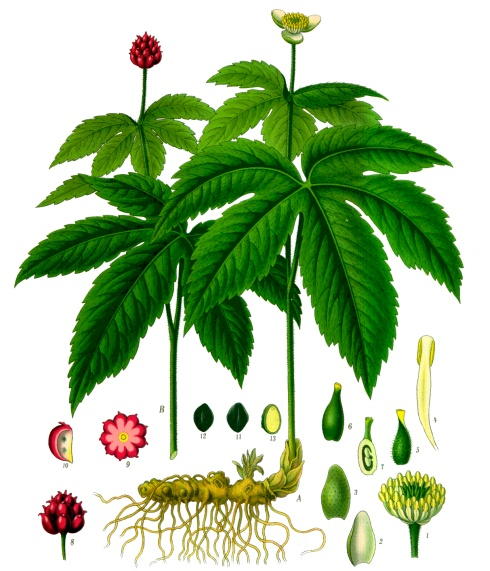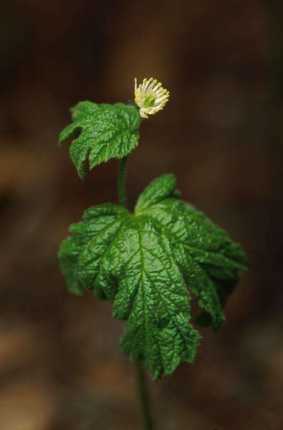
Hydrastis canadensis (L.)
Synonyms: Hydrastis rhizoma, yellow
root, orange root, eye balm, eye root, wild curcuma, ground raspberry, Indian
plant, Indian dye, Indian paint, Jaundice root, turmeric root, yellow puccoon
paint, Jaundice root, turmeric root, yellow puccoon
Order: Ranunculaceae
Description: Hydrastis is a small perennial plant with a single hairy stem producing two five-lobed serrated leaves and a small single apetalous flower with greenish sepals, giving way to a raspberry-like fruit. It grows in rich shady woodlands through north and north-eastern North America, but is rare in the wild and is usually cultivated for commerce.
Parts used: Root and rhizome
Collection: The root and rhizome are unearthed from three-year-old plants in the autumn, after the seeds have ripened.
Constituents: 5% of the root consists of isoquinoline alkaloids )hydrastine, berberine and canadine) chlorogenic acid, traces of essential oil, resin, fatty oil, starch, sugar
Actions: Tonic, astringent, antihaemorrhagic, choleretic, antimicrobial, anticatarrhal, mild laxative, cholagogue, alterative, stimulant to autonomic nervous system and involuntary muscle, stomatic, oxytocic, bitter digestive stimulant, haemostatic, anti-inflammatory, healing to the gut wall and other mucous membranes, hypertensive, sedative to central nervous system, stimulating adjunct to remedies for the lungs, reproductive tract and kidneys
Indications: Digestive disorders, dyspepsia, gastritis, peptic ulceration, colitis, anorexia, upper respiratory catarrh, menorrhagia, post-partum haemorrhage, dysmenorrhoea. Topically for eczema, pruritis, otorrhoea, catarrhal deafness and tinnitus, conjunctivitis.
 Therapeutics and Pharmacology: Hydrastis
has a powerful tonic action on the mucous membranes of the body and is thus of use in
many digestive problems, such as gastritis, ulceration and colitis. It may be
used to treat states of depressed digestion associated with liver disorder or
sensitivity (e.g. to fatty foods and alcohol). It is also a valuable remedy for
the treatment of upper respiratory catarrh. As a bitter stimulant it is useful
in anorexia. Its tonic and astringent actions contribute to its use in
uterine conditions such as menorrhagia and haemorrhage. It helps reduce
menopausal symptoms and can ease pre-menstrual syndromes linked with stagnation.
Therapeutics and Pharmacology: Hydrastis
has a powerful tonic action on the mucous membranes of the body and is thus of use in
many digestive problems, such as gastritis, ulceration and colitis. It may be
used to treat states of depressed digestion associated with liver disorder or
sensitivity (e.g. to fatty foods and alcohol). It is also a valuable remedy for
the treatment of upper respiratory catarrh. As a bitter stimulant it is useful
in anorexia. Its tonic and astringent actions contribute to its use in
uterine conditions such as menorrhagia and haemorrhage. It helps reduce
menopausal symptoms and can ease pre-menstrual syndromes linked with stagnation.
Externally, Hydrastis used in the treatment of eczema, ringworm, pruritis, earache and conjunctivitis. It my be used as a mouthwash for gum disease and mouth ulcers, as a douche for vaginal problems, as eardrops for middle-ear inflammation and congestion, and as a snuff for nasal inflammation.
Berberine is a bitter alkaloid with antibacterial and antiprotozoal effects: it is also sedative to the central nervous system. Hydrastine is a stimulant to the autonomic nervous system and appears to exert astringent effects on mucosal surfaces throughout the body. Canadine is bitter and sedative.
Combinations: Hydrastis combines well with Filipendula and Matricaria in digestive disorders. In uterine haemorrhage it is best combined with Trillium. Externally as a wash for irritation and itching it combines well with distilled Witch Hazel and Passiflora. As ear drops it may be combined with Verbascum. It may be combined with Commiphora resin, Echinacea, Verbascum and Eucalyptus globulus as ear drops, and with Hamamelis leaf and Euphrasia as an eye lotion.
Caution: As Hydrastis stimulates the involuntary muscles of the uterus, it should be avoided during pregnancy. It should not be given in hypertensive conditions. Eating the fresh plant produces ulceration and inflammation of mucous membranes. Used topically, Hydrastis will stain the skin yellow.
Preparation and Dosage: (thrice daily)
Regulatory Status: GSL
Dried rhizome and root: 0.5-1g
Liquid Extract: 1:1 in 60% alcohol, 0.3-1ml
Tincture: 1:10 in 60% alcohol, 2-4ml
Additional Comments: A traditional healing herb of Native Americans, goldenseal was used by the Cherokee for indigestion, local inflammations and to improve the appetite; the Iroquois used it for whooping cough, liver disorders, fevers and heart problems. So popular was it with the European settlers that it was soon over-collected and now has to be specially cultivated. The herb was introduced into Europe in 1760. During the 19th century it was a favourite with Thomsonian and Eclectic practitioners and was listed in the United States Pharmacopoeia until 1926.
Bibliography
BHMA 1983 British Herbal Pharmacopoeia, BHMA, Bournemouth.
Bradley, P.R. (ed.) 1992 British Herbal Compendium, Volume 1, BHMA, Bournemouth.
Grieve, M. 1931 A Modern Herbal, (ed. C.F. Leyel 1985), London.
Hoffmann, D. 1990 The New Holistic Herbal, Second Edition, Element, Shaftesbury.
Lust, J. 1990 The Herb Book, Bantam, London.
Mabey, R. (ed.) 1991 The Complete New Herbal, Penguin, London.
Mills, S.Y. 1993 The Essential Book of Herbal Medicine, Penguin, London (First published in 1991 as Out of the Earth, Arkana)
Mills, S.Y. 1993 The A-Z of Modern Herbalism, Diamond Books, London.
Ody, P. 1993 The Herb Society's Complete Medicinal Herbal, Dorling Kindersley, London.
Polunin, M. and Robbins, C. 1992 The Natural Pharmacy, Dorling Kindersley, London.
Wren, R.C. 1988 Potter's New Cyclopaedia of Botanical Drugs and Preparations, C.W.Daniel, Saffron Walden.










